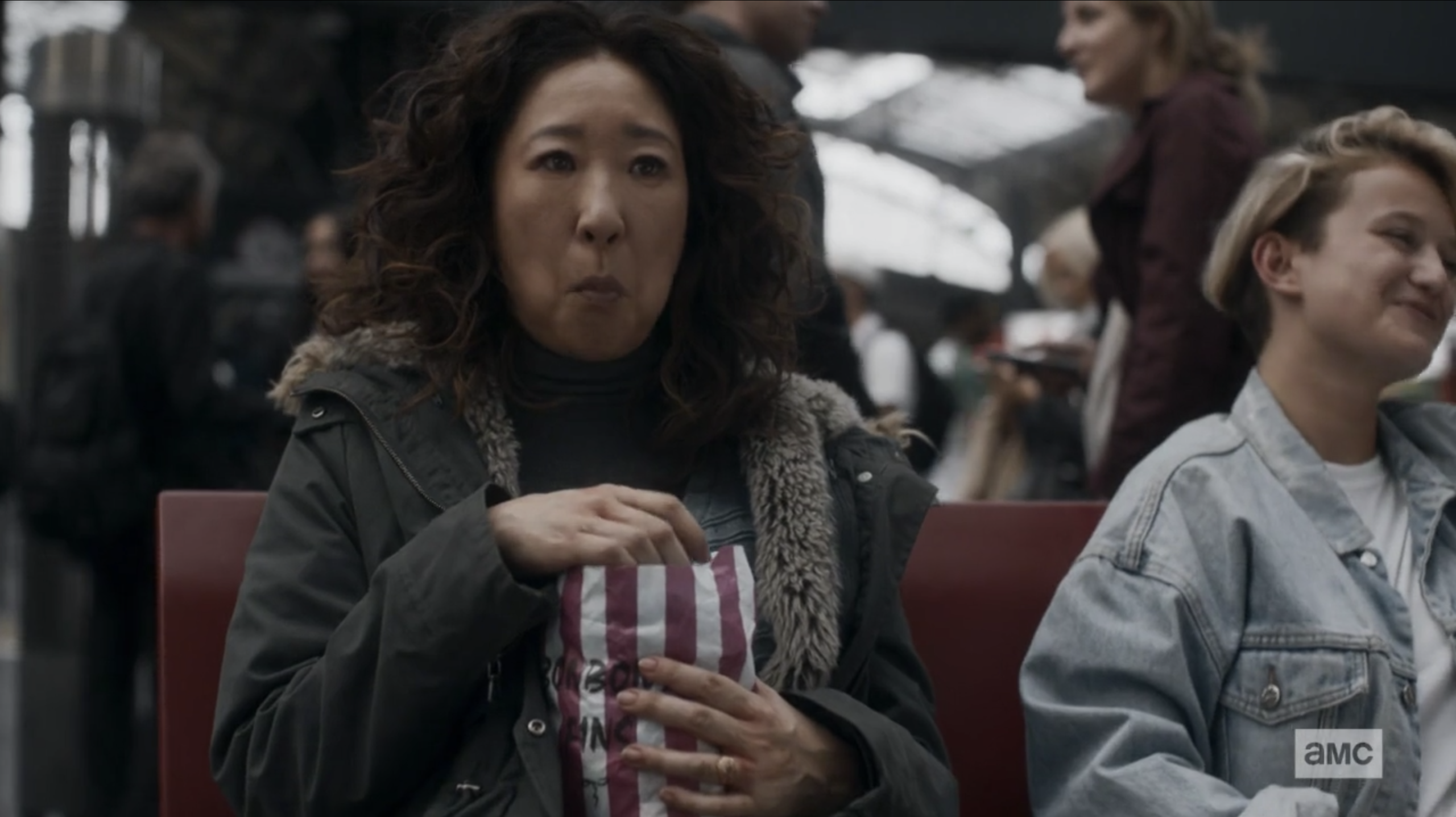I admit it: I am a Killing Eve evangelist. I tell anyone who will listen — unsuspecting muni riders, friends, and dogs alike — this is the show we NEED in these times. At this point, getting every person I know to watch is my unsolicited quest. Who doesn’t want to see Sandra Oh (Eve) portray a MI5 spy chasing a female assassin Jodie Comer (Villanelle)? I mean seriously. Who? I’d like to take this time to apologize to the airpod-wearing tech worker who definitely just wanted to peruse their Instagram feed on her commute home — sorry for making you listen to my impassioned monologue on how this BBC show might be the greatest piece of resistance art in the Trumpian era.
Killing Eve is a deliciously violent, modern, and comedic twist on a will-they-won’t-they tale of killer and detective. At its core are two women, a bored MI5 agent, Eve, and a self aware assassin, Villanelle. Their ever-evolving relationship breaks the mold of women-centered drama, managing to exclude the three M’s: marriage, motherhood, and makeovers. According to the Center for the Study of Women in Television & Film’s 2018 Boxed in Study “female characters were more likely than male characters to play personal life-oriented roles such as wife and mother” — so definitely not a spy and an assassin.
While Eve is married, her relationship doesn’t drive her and in fact, takes a to her true passion — her job of overcoming Villanelle and the conspiracy she kills for. And while the thought of a female driven spy/assassin show might ring some alarm bells, Killing Eve rejects the traditional roles action films and television have left women. This is not Charlie’s Angels or another Bond film: neither character is defined by their sex appeal and neither of them are the sidekick to a problematic male figure. The only fatal attraction seems to be between the women themselves and their strange infatuation with each other.
In season one, the creators of Killing Eve took their time with each character giving Eve and Villanelle the time to develop complex narratives and motivations while separate from each other. Slowly the show reveals the threads that connect Eve and Villanelle, whether it’s their shared ability to dissociate (comically so) or a sudden exhilaration when they discover they are in the same room. Season one is dominated by Eve’s quest to find Villanelle as she chases her using her latest victims as bread crumbs.
Their obsessions culminates when Eve finally catches Villanelle in her apartment. The two share an electric moment, both overwhelmed by their infatuation with one another. The dialogue could be mistaken for a high school rom com as the two confess their love for one another. Suddenly, right as the audience (and Villanelle) think they are going to kiss, Eve stabs Villanelle. Confused and shocked by what she has just done, Eve first attempts to try to save Villanelle before an equally shocked Villanelle starts trying to shot her and both women escape.
This is where season two picks up (exactly thirty seconds later as the title cards hilariously tell us) as Eve struggles to come to grips what she has just done and what it might mean. Eve narrowly escapes Villanelle’s apartment building, struggling to even recognize her surrounding as she admits to murder in front of a newly engaged couple. Oh is hilariously entertaining as she settles into her new found place as a-maybe murderer. She goes to a candy store, overfilling a bag with a glutinous amount of jelly beans and gumdrops, and quite frankly I’m not surprised. If there is anything we learn as children, it’s that candy always tastes good. Even after an attempted murder. This scene gives us a quick visual cue that Eve might be more similar to Villanelle than she thinks. In the iconic first scene of Killing Eve season one, Villanelle spills ice cream on a young girl. While buying candy, Eve stops a young boy from taking on of her gumdrops. Is it a throwback to childhood pettiness or do they simply both dislike children.This complexity reinforces one of the themes of the show where the lines between purely good or bad are blurred. While Eve heads to the train station, Villanelle stumbles through the city eventually throwing herself in front of a cab to get a ride to the hospital. Forgetting she still has the knife she stabbed Villanelle with in her pocket, Eve quickly exits the security line, deciding to throw away the knife in the most “bloody” ironic place: a sanitary napkin trash can.
Killing Eve is so enthralling and new because it dramatizes traditional women roles, subverting them with darkness and humor. See the scene where Eve is preparing dinner when her husband reveals she forgot to even take the chicken out of the fridge. It’s watching Eve’s older boss Carolyn Martens sitting with a child who hilariously turns out to be a stranger. It’s watching Villanelle escape the hospital in a wheelchair after telling a well-meaning security guard that she’s just been diagnosed with a terrible illness and simply needs some time alone. Watching security guard fall fall into the societal narrative that women are harmless and must be protected, feels like righteous revenge. Women are the drivers of this show and none of them are purely good or bad. Each is meticulously crafted, disrupting the assumptions and stereotypes we’ve been taught. Who knew a spy story would be the perfect vehicle to bend gender stereotypes? But it is.?
This is the brilliance of Killing Eve, the ability to be equally terrifying, hilarious, and poignant at the same time. It’s feels good to have Villanelle and Eve back in our lives for a second season. And if there’s one thing I know, women aren’t predictable and neither is Killing Eve.

